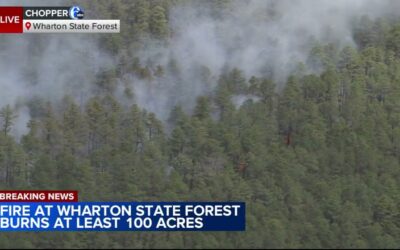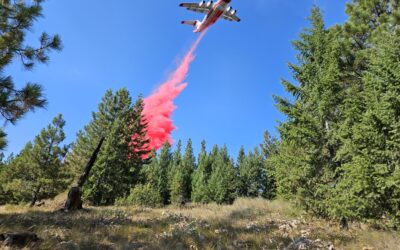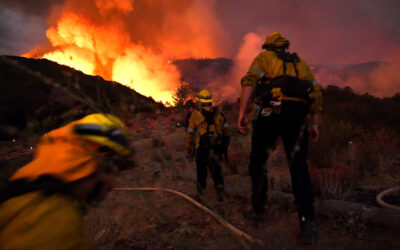Kacie Yamamoto – The Honolulu Star-Advertiser
Mar. 9—The fire sensor technology, which was developed by the Department of Homeland Security Science and Technology Directorate and the U.S. Fire Administration in partnership with small business N5 Sensors Inc., will be deployed by the federal government.
Seven months after the August wildfires on Maui, the U.S. Department of Homeland Security on Friday announced the implementation of new wildfire detection technology that can sense smoke and particles from fires and alert authorities, enabling a faster response to stop the spread of wildfires across the state.
“Reflecting on the tragedy that our people have endured over the last seven months, fire mitigation also remains at the forefront of our recovery efforts, ” Maui County Mayor Richard Bissen said Friday at a news conference. “We are already exploring ways to rebuild Lahaina safer and the introduction of an early detection system, which will give our emergency responders a critical advantage in protecting our community. With this new technology, detecting fires at the very early phases will save lives.”
The fire sensor technology, which was developed by the Department of Homeland Security Science and Technology Directorate and the U.S. Fire Administration in partnership with small business N5 Sensors Inc., will be deployed by the federal government at no cost to the state.
Eighty Beta wildfire sensor units will be installed statewide—20 units each for Maui County, Hawaii County, Kauai County and the City and County of Honolulu—by April 8. The 80 units are part of 200 units that Homeland Security will deploy to “high-risk areas ” across the country this year. An additional 16 wind sensors also will be deployed across the state.
According to N5 Sensors Inc. Chief Revenue Officer Debra Deininger, each fire sensor device will take 30 measurements of gases, chemicals, particles and environmental conditions, and use “edge processing ” to send measurement data to servers to be analyzed utilizing artificial intelligence. An infrared heat sensor in the device also will give personnel a better idea of a fire’s severity.
Deininger also said the company will work with fire departments on how they would like to be notified by the system when a fire is detected but that a text alert will be sent to “whoever is opted in ” with a link to the location of where a fire is believed to be.
Maui County Fire Chief Brad Ventura said the department is still in the early phases of identifying where the notifications will go internally but that the notifications will probably be sent to “a small group of members ” in the department that always has someone on duty, who will notify the fire station in the suspected fire’s district to send resources immediately.
The technology aligns with the USFA’s “three-part cohesive strategy ” to mitigate wildfires across the country and includes managing rapidly burning vegetation, building fire-resistant structures in communities and implementing an “effective response ” to wildfires. The fire sensor technology, the USFA’s Lori Moore Merrell said, will provide early alert information to inform firefighters to move more quickly to stop a fire’s spread.
“As we work with the Hawaii fire departments to place and test these fire sensors, we are grateful to be able to contribute to the resilience of this community, as Lahaina certainly continues to recover and Hawaii prepares for future weather events, ” Merrell said.
Initial trials of the sensors have been conducted in 11 states and Canada through December. Now the sensors are entering their second phase of testing, which involves testing them in different environments. Hawaii is the first location in which these Beta sensors are being tested.
Undersecretary for Science and Technology Dimitri Kusnezov said part of the reason the sensor technology is now being deployed in Hawaii is due to the difference in the air in the state versus in other areas of the country.
“Part of it is to figure out, ‘What does the natural condition of the environment look like here ?’ and the second is, ‘Well, what is something that is different from that ?’ and ‘How do you alert and prepare and feed into the emergency operations here in Hawaii to help people be more advanced in their understanding of what could transpire ?'” Kusnezov said.
According to Deininger, the sensors will begin sending data immediately once they are installed, but they might be “slightly less accurate ” in the first days and weeks of their use, when they are learning the environment.
“It’s part of an evolution. This is still development of a smarter technology to give us more advanced awareness, ” Kusnezov said. “I think this is our next step in a progression of advanced awareness that can help us.”
The sensors will be placed strategically in “known high-risk fire areas, ” said state Department of Defense Adjutant General Maj. Gen. Kenneth Hara. The state Emergency Management Agency is working with USFA and the Homeland Security Science and Technology Directorate to gauge the feasibility of installing the sensors on existing infrastructure statewide, such as poles of hazard sirens.
Ventura also said the department is working with these federal and state partners on the possibility of installing the sensors on other existing infrastructure but that sensors will be installed on county properties “as quickly as possible.”
“Obviously, our goal is to always beat the next fire season with our training, with our equipment, and get everything out in front of the fire season, ” Ventura said.
Two “strings ” of sensors will be deployed in Maui County—one across Kihei and one from the Olowalu to Hokiokio area of Lahaina—in areas the department feels “have high risk ” for the community.
“The areas that we placed them in, that’s where we’re going to have slowly detected wildfires, ” he said. “There’s potential if there’s a wildfire right across the street here with all these homes and people driving around that we’ll have people doing early detection, but at night at 2 o’clock in the morning, if something odd happens in the field, that’s something that all the particulate sensors will be picking up prior to maybe somebody seeing it and calling 911.”
The implementation of the sensors in strings will allow the sensors to “kind of talk to each other, ” Ventura said, and verify a wildfire detection together, which will allow firefighters to better determine the size of wildfires, how quickly the fires are progressing and what resources are needed.
“We need every innovation possible, from the equipment in the station to the equipment in the field, to help us with early detection. This will also increase our response and capability to get into the scene, ” Ventura said. “The sooner we can get there, the smaller the fires will be.”
If the sensor implementation program is successful, Ventura said, the department will be able to deploy more sensors in other areas throughout the county.
The sensors rely on cellular data to send notifications of detected fires to personnel, so Ventura said the department met with FirstNet, a company that oversees the first-responder broadband network, to discuss increasing cellphone service in the county to deploy sensors in more rural areas.
Other technologies that don’t rely on cellular service are also in development but are not being deployed with the sensors at this time.
In addition to the announcement of the sensor technology, Gov. Josh Green also discussed other actions being taken by various state departments and federal partners in Maui’s recovery.
The state Department of Land and Natural Resources is maintaining 18 miles of firebreaks across West Maui, Green said, with an emphasis on managing vegetation along the firebreak routes. The department has also been working on clearing hazard trees and burn areas, and plans to reopen the Waihou Spring Trail on April 1.
The state Department of Transportation also is working on constructing additional evacuation routes and emergency access roads in Lahaina. Green also said the state Legislature is discussing funding for Maui’s recovery effort, including for dip tanks and fuel mitigation in West Maui.
“We continue to recover, as everyone knows, and to heal as a state. We continue to invest in our many strategies to get back on our feet, ” Green said. “Inevitably, Maui will recover completely.”
___
(c)2024 The Honolulu Star-Advertiser
Visit The Honolulu Star-Advertiser at www.staradvertiser.com
Distributed by Tribune Content Agency, LLC.




